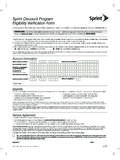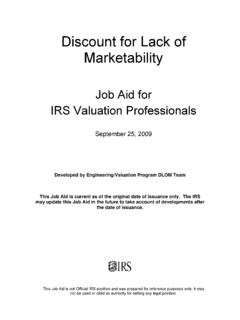Transcription of Concept 9: Present Value Discount Rate
1 Concept 9: Present Value Is the Value of a dollar received today the same as received a year from today? A dollar today is worth more than a dollar tomorrow because of inflation, opportunity cost, and risk Bringing the future Value of money back to the Present is called finding the Present Value (PV) of a future dollar1 Discount Rate To find the Present Value of future dollars, one way is to see what amount of money, if invested today until the future date, will yield that sum of future money The interest rate used to find the Present Value = Discount rate There are individual differences in Discount rates Present orientation=high rate of time preference= high Discount rate Future orientation = low rate of time preference = low Discount rate Notation: r= Discount rate The issue of compounding also applies to Present Value computations.
2 2 Present Value FactornrPVF)1(1+= To bring one dollar in the future back to Present , one uses the Present Value Factor (PVF):3 Present Value (PV) of Lump Sum MoneynrPPVFPPV)1(1+ = = For lump sum payments, Present Value (PV) is the amount of money (denoted as P) times PVF Factor (PVF)4An Example Using Annual Compounding ,55%)61(1000,10010=+ = =PVFPPV Suppose you are promised a payment of $100,000 after 10 years from a legal settlement. If your Discount rate is 6%, what is the Present Value of this settlement?5An Example Using Monthly ,30$ *000,100%)11(1000,100120==+ = =PVFPPV You are promised to be paid $100,000 in 10 years. If you have a Discount rate of 12%, using monthly compounding, what is the Present Value of this $100,000? First compute monthly Discount rate Monthly r = 12%/12=1%, n=120 months6An Example Comparing Two Options Suppose you have won lottery.
3 You are faced with two options in terms of receiving the money you have won: (1) $10,000 paid now; (2) $15,000 paid five years later. Which one would you take? Use annual compounding and a Discount rate of 10% first and an Discount rate of 5% next. 7 Your answer will depend on your Discount rate: Discount rate r=10% annually, annual compounding Option (1): PV=10,000 (note there is no need to convert this number as it is already a Present Value you receive right now). Option (2): PV = 15,000 *(1/ (1+10%)^5) = $9, Option (1) is better Discount rate r= 5% annually, annual compounding Option (1): PV=10,000 Option (2): PV = 15,000*(1/ (1+5%)^5) = $11, Option (2) is better8 Present Value (PV) of Periodical Payments For the lottery example, what if the options are (1) $10,000 now; (2) $2,500 every year for 5 years, starting from a year from now; (3) $2,380 every year for 5 years, starting from now?
4 The answer to this question is quite a bit more complicated because it involves multiple payments for two of the three options. First, let s again assume annual compounding with a 10% Discount rate. 9 Annual Discount rate r= 10%, annual compounding Option (1): PV=10,000 Option (2): PV of money paid in 1 year = 2500*[1/(1+10%)1] = PV of money paid in 2 years = 2500*[1/(1+10%)2] = PV of money paid in 3 years = 2500*[1/(1+10%)3] = PV of money paid in 4 years = 2500*[1/(1+10%)4] = PV of money paid in 5 years = 2500*[1/(1+10%)5] = Total PV = Sum of the above 5 PVs = 9, Option (3): PV of money paid now (year 0) = 2380 (no discounting needed) PV of money paid in 1 year = 2380*[1/(1+10%)1] = PV of money paid in 2 years = 2380*[1/(1+10%)2] = PV of money paid in 3 years = 2380*[1/(1+10%)3] = PV of money paid in 4 years = 2380*[1/(1+10%)4] = Total PV = Sum of the above 5 PVs = 9, Option (1) is the best, option (3) is the second, and option (2) is the Are there simpler ways to compute Present Value for periodical payments?
5 Just as in Future Value computations, if the periodic payments are equal Value payments, then Present Value Factor Sum (PVFS) can be used. Present Value (PV) is the periodical payment times Present Value Factor Sum (PVFS). In the formula below Ppdenotes the periodical payment: PV=Pp*PVFS11 Present Value Factor Sum (PVFS) If the first payment is paid right now (so the first payment does not need to be discounted), it is called the Beginning of the month (BOM):rrrrrPVFSnn1110)1(111)1( )1(1)1(1 + +=++++++=12rrrrPVFSnn)1(11)1( )1(11+ =++++= If the first payment is paid a period away from now, then the first payment needs to be discounted for one period. In this case, the end of the month (EOM) formula applies:13 BOM or EOM In most cases End of the Month (EOM) is used in PVFS computation.
6 So use EOM as the default unless the situation clearly calls for Beginning of the Month (BOM) calculation. Appendix PVFS Table uses EOM. , )51(112500),5%,5(25005= =+ === =EOMnrPVFSPV Use PVFS to solve the example problem but use a 5% Discount rate: Discount rate r=5% Option (1): PV = 10,000 Option (2) , )%5%)51(111(2380),5%,5(238015= =+ + === = BOMnrPVFSPVO ption (3):Option (2) is the of Present Value : Computing Installment Payments You buy a computer. Price=$3,000. No down payment. r=18% with monthly compounding, n=36 months. What is your monthly installment payment M? The basic idea here is that the Present Value of all future payments you pay should equal to the computer price. ) (113000),36%, (3000),,36%, (300036==+ ====== =EOMnrPVFSMEOMnrPVFSM Answer: Apply PVFS, n=36, monthly r=18%/12= , end of the month because the first payment usually does not start until next month (or else it would be considered a down payment)17 Application of Present Value : Rebate vs.
7 Low Interest Rate Suppose you are buying a new car. You negotiate a price of $12,000 with the salesman, and you want to make a 30% down payment. He then offers you two options in terms of dealer financing: (1) You pay a 6% annual interest rate for a four-year loan, and get $600 rebate right now; or (2) You get a 3% annual interest rate on a four-year loan without any rebate. Which one of the options is a better deal for you, and why? What if you only put 5% down instead of 30% down (Use monthly compounding) In this case because your down payment is the same for these two options, and both loans are of four years, comparing monthly payments is sufficient. 1830% down ) (117800),48%, (780048==+ ====EOMnrPVFSM Option 2. The amount borrowed: 12,000*(1-30%)=8,400 Monthly r=3%/12= , n=48 ) (118400),48%, (840048==+ ====EOMnrPVFSM Option 1.
8 Amount borrowed is 12,000*(1-30%) 600 =7,800 Monthly r=6%/12= , n=48 monthsOption 1 is better because it has a lower monthly payment195% down ,10% ) (11800,10),48%, (800,1048==+ ====EOMnrPVFSM Option 2. The amount borrowed: 12,000*(1-5%)=11,400 Monthly r=3%/12= , n=48 ,11% ) (11400,11),48%, (400,1148==+ ====EOMnrPVFSM Option 1. Amount borrowed is 12,000*(1-5%) 600 =10,800 Monthly r=6%/12= , n=48 monthsOption 2 is better now because it has a lower monthly payment20 Application of Present Value :Annuity Annuity is defined as equal periodic payments which a sum of money will produce for a specific number of years, when invested at a given interest rate. Example: You have built up a nest egg of $100,000 which you plan to spend over 10 years.
9 How much can you spend each year assuming you buy an annuity at 7% annual interest rate, compounded annually ? ,14$ ,100%7%)71(11000,100),10%,7(000,100),,10 %,7(000,10010==+ ====== =EOMnrPVFSMEOMnrPVFSM Annuity calculation is an application PVFS because the Present Value of all future annuity payments should equal to the nestegg one has built up. 22 If you know how much money you want to have every year, given the interest rate and the initial amount of money, you can compute how long the annuity will last. Say you have $10,000 now, you want to get $2,000 a year. The annual interest rate is 7% with annual compounding (EOM)23 Approximate solution: Step 1: $10,000/$2,000 = 5 Step 2: Find a PVFS that is the closest possible to 5 PVFS(r=7%, n=5, EOM) = PVFS(r=7%, n=6, EOM) = close to 5 PVFS(r=7%, n=7, EOM) = close to 5 Because 5 is in-between PVFS(n=6) and PVFS(n=7), this annuity is going to last between 6 and 7 years Exact solution: $10,000/$2,000=5 5=PVFS (r=7%, n=?)
10 , EOM) => 5=[1- 1/(1+7%)^n]/7% ( )^n ( )^n 1 ( )^n Log(1 )=n log( ) n=log(1 )/log( )= years Note: Homework, Quiz and Exam questions will ask for approximate solution, not the exact solution, although for those who understand the exact solution the computation can be easier. 24 Appendix: A Step-by-Step Example for PVFS ) (11%7%)71(11)%,7,5(555== = = =+ =+ ===EOMrnPVFS25





